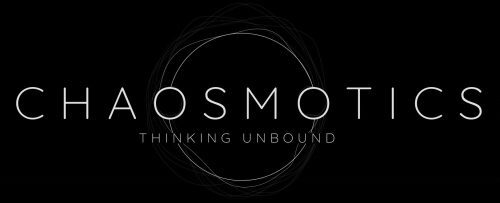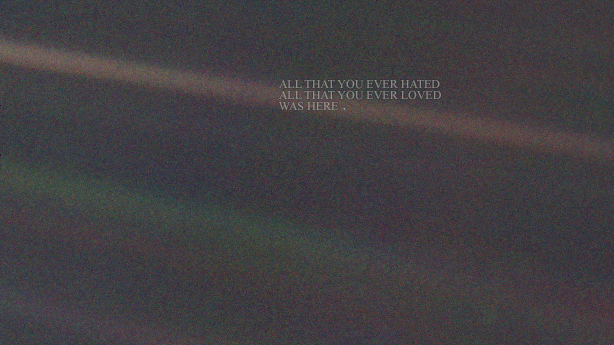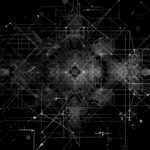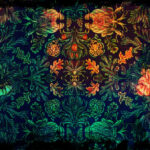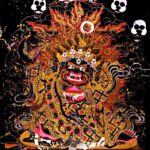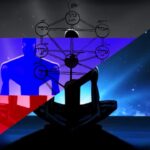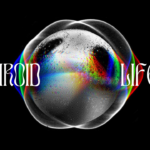The pale blue dot in the image is the Earth. The picture was taken in 1990 by the Voyager 1 space probe while it was about six billion kilometres away, somewhere beyond Neptune’s orbit.
- When the world stopped being just a world
The distinction between weird, unheimlich, and eerie is subtle. The three concepts seem to relate in some way to the external, but each time declining it in a different way: if in the uncanny the external is caught within the familiar and in the weird it enacts a re-connotation of the internal, in the eerie it can be conceived «in an immediately empirical sense, as well as in a more abstract transcendent one» (Fisher 2017, 11). Unlike the unheimlich, at least as it descends from Werber1, the eerie is not evoked by the circumscribed places around the inhabited domestic hearth, but is typical of landscapes deprived of human presence.
The eerie thus seems to act by subtraction: it is not the direct presence of the exterior that qualifies it, but the absence of the interior. If the absence of the interior appears as the presence of the exterior – if the inaccessible is manifested by subtraction – it is clear how the eerie is linked to the concept of agency: «what kind of agent operates in this case?». If in the dynamics of the perturbing it was the status of the object that was questioned, in those of the eerie, as in the case of the weird, the question about the object turns in on itself, bringing the subject itself into question. The eerie interrogates existence and non-existence in their mutual envelopment: «Why is there something here when there should be nothing? Why is there nothing here when there should be something?» (Fisher 2017, 12). In contrast to the weird – which is triggered by a shock, by the sudden detachment between the everyday and the extraordinary – the eerie proceeds through a slow dissolution of the everyday. If the weird, to be such, must be caused by the irruption of a presence, by a failure of absence, the eerie instead crystallises in negation, in what is defined, on the contrary, as a failure of presence.
Since, according to Fisher, a paradigmatic example of this kind of failure is given by the topos of the abandoned village, what we can now ask ourselves is what is the degree of thinkability of a landscape stripped of human presence: what remains of the anthropocentrically characterised world with the disappearance of the anthropic element? In the Italian afterwords to The Weird and the Eerie, Gianluca Didino describes how the occurrence of events such as global warming has made new interpretative grids necessary in order to make it possible to confront what is unthinkable. How, then, to think after the end of the world? As Danowski and Viveiros de Castro report, it is the near future that has become unimaginable. If, according to correlationism, the end of the world implies in itself the end of thinking of that world, it is then necessary to define «for whom this ending world is a world» (Danowski & Viveiros de Castro 2017, 55), who is the subject that definitively sanctions the end of everything. In the dualism man without world/world without man – whether it is projected before the appearance or after the disappearance of homo sapiens – what remains constant is the degree of totalising unthinkability that permeates its structure. Eugene Thacker identifies this unthinkability as the starting point for his analysis of the possibility of a world without us:
The world is increasingly unthinkable – a world of planetary disasters, emerging pandemics, tectonic shifts, strange weather, oil-drenched seascapes, and the furtive, always-looming threat of extinction. (Thacker 2019, 11).
While the realm of the unthinkable has long been relegated almost exclusively within the supernatural horror genre, Thacker’s theoretical project is to enact not so much a philosophy of horror, but rather the horror of philosophy: not horror as an interpretative category of reality, but the identification and analysis of the very limit of philosophy.
Thacker carries out two operations: firstly, he identifies in the notion of world the entity in which horror and philosophy are able to communicate; secondly, he theorises, and at the same time postulates, three different coexisting worlds that he defines as world-for-us, world-for-self and world-without-us. This distinction between worlds stems from the observation that, given the intimately human nature of the thinking subject, most attempts to think about the world throughout history have resulted in an anthropocentric view2. The world resulting from our act of signification, the world in which we live by perceiving it and establishing it as our own, is what Thacker calls the world-for-us. The second declension, the world-in-itself, is constituted in opposition to the world-for-us: it is the substratum that operates a friction to the act of signification, a resistance to our attempt at submission. The world-without-us, decisive for our treatment of the eerie, arises from the human attempt to overlook the world–in-itself, as if we were «almost fatally attracted to it, as if it were the limit that defines us as human beings» (Thacker 2019, 13):
Let us call this spectral and speculative world the world-without-us. In a sense, the world-without-us allows us to think the world-in-itself, without getting caught up in a vicious circle of logical paradox. The world-in-itself may co-exist with the world-for-us – indeed the human being is defined by its impressive capacity for not recognizing this distinction (Thacker 2019, 13).
The world-without-us, on the other hand, being the product of man’s removal from the world, can in no way coexist with the world-for-us. At the same time, to think of it as the antithesis of the world-for-us would be to fall back into anthropocentric deception: the world-without-us is located on the threshold, in a nebulous and inaccessible zone. Thacker makes a further specification, identifying the three declinations with three different nouns: to the world-for-us corresponds the World, to the world-for-self the Earth and to the world-without-us the Planet.
The term world has always been laden with a potential anthropocentrism: «”World”, “worlding” are frequently employed in phenomenology to describe the way we human subjects exist in the world» (Thacker 2019, 14); the “world” is a domesticated entity – lost in its own world! – which already presupposes within its semantics the presence of the human being. Earth, on the other hand, indicates the physical substratum, the world in its cosiness, deprived of the intimacy suggested using world: disciplines such as geography, hydrology and geology are part of what are called earth-sciences; within them the world is analysed with detachment and considered as an object of study. Finally, the Planet is what is not revealed: if the Earth – since the tools used to analyse it are based on human perceptual capacities and either amplify them, or cause others to be brought back to them – is still defined and visualisable on a human scale, the Planet, on the other hand, «goes beyond the subjective World, retracting itself even from the objectivity of the Earth» (Thacker 2019, 14); the planet Earth, as well as the planet Uranus or the planet Saturn, is a planet among others, a planet that remains – by subtraction – after the human. The world-without-us is configured as the actualisation of Lovecraftian cosmic indifference: a nature with Leopardian traits that perpetuates itself inexorably in solitude. As Ligotti sentences, in the natural world «nothing is aware of its own turmoil in the festival of massacres» (Ligotti 2016, 13).
The planet, impersonal and anonymous, is thus the eerie entity par excellence: nothing where there should be something – our everything. According to Thacker, the only way to break free from the anthropocentric view of the relationship between man and nature – which separates the two entities on different ontological levels – is through cosmic pessimism:
The view of Cosmic Pessimism is a strange mysticism of the world-without-us, a hermeticism of the abyss, a noumenal occultism. It is the difficult thought of the world as absolutely unhuman, and indifferent to the hopes, desires, and struggles of human individuals and groups. Its limit-thought is the idea of absolute nothingness (Thacker 2019, 26).
2. Demons and Swarms
Outside, daytime. Claire uses a rudimentary instrument created by her son to probe the trajectory of the planet Melancholia’s orbit: an iron wire twisted around itself and attached to the tip of a stick, capable of detecting whether the planet is moving away from or closer to the Earth. The first measurement is made by pointing the stick at his chest and modelling the shape of the wire on the planet’s circumference; the second, after five minutes, consists of simply repeating the same movement: if the planet appears smaller than the metal circle, it means it is moving away, while the opposite case implies that it is moving slowly towards the Earth. Claire, making the second measurement, observes the planet trespassing the limits set by the metal spiral: the apocalypse has begun. The planet, a representation of the inhuman exterior, exceeds the limits set by human technology, revealing its silent and blind destructive agency.

In fact, Melancholia shows the contrast between the human world and “the cosmos-without-us, the austere ballet of spheres evolving sublimely in the great void of the solar system and beyond” (Danowski & Viveiros De Castro, 87). According to the two authors
The clash with planet Melancholia is the event to end all events, and time itself, in the same sense in which Anders referred to nuclear apocalypse: no one is left, there is no offscreen voice to comment on the end of the world. Real time disappears to the point that it is impossible even to imagine the verbal tense in which to narrate what cannot be narrated apart from a mute “present” (no one is left, there is no voice). The impact is followed by darkness or, rather, a black screen, the pure absence of images, silence, nothingness (Danowski & Viveiros De Castro, 2014, 88).
The insignificance of the Earth’s role in the trajectory of the planet Melancholia is reflected in Lovecraft’s theorisations on the condition of human life. Thacker, in his Cosmic Pessimism, provides a definition of cosmic pessimism based on Lovecraft’s cosmic indifference: whereas in Lovecraft, in the absence of a recognisable divinity, human beings are presented as insignificant within the cosmic dimension, in Thacker:
Is first and last a pessimism about cosmos, about the necessity and possibility of order (…). The contours of cosmic pessimism are a drastic scaling-up or scaling-down of the human point of view, the unhuman orientation of deep space and deep time, and all of this shadowed by an impasse, a primordial insignificance, the impossibility of ever adequately accounting for one’s relationship to thought (Thacker 2015, 18).
For Schopenhauer, a very dear author to Thacker, if we want to think of the world in itself – something similar to the world-without-us – it is necessary to overturn the very premises of thought and philosophy3: the absence of meaning must be taken into consideration as a concrete possibility. Even if there is an order in the cosmos, it does not include the human being and is knowable in a purely negative way through what Schopenhauer calls Vorstellung, the negative awareness constituted by our conception of the world. What moves beyond representation is the Wille – the will – the abstract, unconscious and eternal principle, blind to human needs and desires.
According to Thacker, the persistence of the figure of the demon, across times and places, is a symptom of a specifically non-human otherness that moves in a perpetual trespassing of borders: the demon, the vehicle of this otherness, can be conceptualised «in an anthropomorphic framework as a metaphor for human nature and the relations that human beings have with each other» (Thacker 2019, 23). The first uses of the term date back to classical Greece: the Heraclitean maxim ethos anthropoi daimon identifies the daimon as an inspirational entity that guides human beings in their decisions. The famous daimon by which Socrates was accompanied, was experienced by the philosopher as a torment: an inner voice that appeared not only to indicate how to think and act, but also to dissuade him from performing certain actions. Plato himself refers to the daimon on two occasions: both from Timaeus4 and from The Republic5 the daimon emerges as an entity not belonging to the earthly reality, which – in a not necessarily malignant way – haunts us and co-owns us.
The relationship between the demon and the evil force was triggered by the advent of early Christianity, with which the demon was conceived of as a threat, instead of being merely the carrier of a neutral exterior. Thacker traces a brief genealogy of the demon thus understood:
Here is the classical demon, which is elemental, and at once a help and a hindrance (“the demon beside me…”); there is the Medieval demon, a supernatural and intermediary being that is a tempter (“demons surround me…”); a modern demon, rendered both natural and scientific through psychoanalysis, and internalized within the machinations of the unconscious (Thacker 2019, 34).
Finally, what concerns us: a contemporary demon who is the bearer of social and political antagonisms, the undefined Other. The demon, in all its epochs, belongs neither to the human nor to the non-human; as for weird and eerie, it is the concept of threshold between inside and outside that is fundamental: the demon is the instrument through which it is possible to weave a relationship between the two parts. If the non-human is the limit – the inaccessible unknown – it is with the demon that, as a threshold, a glimmer towards the outside is made possible. Thacker, referring to the demon of Jerash6, describes how the demon, before being expelled from the body, reveals that it is called Legion – because within it we are many.
According to Thacker, in the parable, demons are manifested in three ways, «each of which testifies to the limits of human understanding of the non-human» (Thacker 2019, 37): firstly, since possession involves several demons but only one individual, the relationship that indissolubly binds a single person to a single body is transgressed. The demon, after having been expelled from the body, hides in a herd of animals – the second manifestation – which finally leads to the third manifestation: the popular word of mouth7. What characterises the three manifestations is the absence of an organisation on the part of the non-human entity that transcends and simultaneously challenges the authority of the rational being. If the human being can relate either to himself or to the world, then he must be able to do so.
And these two types of relations overlap with each other: the human can only understand the human by transforming it into an object to relate to (psychology, sociology), while the human can only relate to the objective world itself by transforming the world into something familiar, accessible, or intuited in human terms (biology, geology, cosmology). (Thacker 2019, 39)
The demon is configured as an instrument, to represent the non-human perspective as a meontological entity8 for which affirmation coincides with negation.
In Dante’s Inferno, three further types of demons can be distinguished: if Lucifer, placed in the centre of the underworld confined from the waist down in the ice of Cocytus, represents the archdemon – the centralised anti-sovereign and transcendent with respect to the governed – and is not distinguished by many actions, there are two other well-characterised categories. The first is that of the Malebranche, the devils who guard the V Bolgia of the VIII Circle of Hell, in which the barters are punished; they – black, winged, armed with sticks with which they force the damned to remain immersed in pitch – are characterised by Faustian traits, like a «small nomadic herd» (Thacker 2019, 42) acting in a decentralised manner. The third type is described in the circle of the lustful where «La bufera infernal, che mai non resta / mena li spiriti con la sua rapina: voltando e percotendo li molesta» (Canto V: 31-33); the storm is not the background against which the demon presents himself, but represents the demon himself. The young lovers, Paolo and Francesca, when questioned by Dante, emerge timidly from the amorphous flow that drags them along; the black wind in which they are immersed behaves like a veritable flock, a swarm that annuls the identities of the damned.

Thacker, in a short text published in Ctheory, focuses on the concept of the swarm, analysing it as an example of mutation in contemporary body politics. While the concept of the swarm is primarily a biological concept, it has its roots in ethology: the study of animal behaviour assumes that organisms are never just individuals or just groups, but that the way an organism behaves is given by the intersection of individual, group and environment. A swarm is first of all the organisation of several individual units with at least one point of reciprocal relationship, a kind of connective collectivity; it is defined in relationality, both at the individual level – of the individual entity – and at the general level – of the whole swarm. Secondly, the swarm is a dynamic phenomenon: it is configured as a persistent element in time and, as such, it acts and interacts, changing continuously. Unlike networks, the swarm is – despite its heterogeneity – a whole that is more than the sum of its parts. Self-organising principles require that the group arises ‘only from the localised, singular and heterogeneous actions of individual units’; it may display a recognisable global pattern, but this does not mean that a swarm prioritises the group over the individual. It follows that the swarm does not exist on a local or global level, but on a third level consisting of the interweaving of multiplicity and relation. In contrast to the concept of multitude
By contrast, swarms are based less on exchanging data through channels, than through the continual modification of action, motion, and movement through the affective signals of local states (state of self, state of nearest neighbors, state of environment). Just any large grouping of people does not constitute a swarm.
It follows that the individual can exist without a swarm, but that the swarm depends essentially on the entities that compose it. The presentation of a mass of individuals – of what in life were individuals – in a form that, by definition, denies human presence, necessarily leads to a rethinking of the status of what is presented before the eyes of Dante and Virgil. The form in which souls are presented is the «most striking (…) and at the same time the emptiest form of life» (Thacker 2019, 45): in the demon of the lustful circle there is neither a «transcendent and sovereign cause nor a radiant emanative flow» (Thacker 2019, 45) but an immanent and, at the same time, never quite present entity. According to Thacker, Dante’s Inferno demonstrates how possession does not exclusively correlate the human being and the outside, but also the inside and the outside, that is, the landscape – hence the world itself – and otherness. What needs to be done is «to begin to think of the demon as an ontological problem: not theological, not poetic, but philosophical» (Thacker 2019, 55); a means of investigating those areas that have always proved problematic for the tools of philosophy, such as negation, nihilism and the non-human.
It is necessary to distinguish this new demonology firstly from anthropology – in which the demon is a simple substitute for the human being – and secondly from metaphysics, in which it takes on the function of «replacing the being/non-being pair» (Thacker 2019, 55).
Denying the anthropological view means considering the world as not simply the world-for-us or the world-in-itself, but as the world-without-us. Likewise denying the view of metaphysics means considering the unreliability of the principle of sufficient reason for thinking about the world (Thacker 2019, 55).
Thacker coined the term demontology precisely to indicate the distance from an anthropology in which man and cosmos are clearly separated; it deals with the thought of the negative definition of nothingness, which does not coincide with the privative definition of non-being. The challenge of demontology is to answer the «how can the world be rethought as unthinkable, that is to say in the absence of a human-centric point of view?» (Thacker 2019, 58).
End of Part One.
Notes
- N. Werber, Professor of German Literature at the University of Siegen, in his Gestalten des Unheimlichen. Seine Struktur und Funktion bei Eichendorff und Hoffmann, provides a genealogy of the term unheimlich. In medieval Europe, among the less well-off and educated classes, the difference between the terms heimlich and unheimlich was confined to the spatial sphere: while the former term denoted what was contained within the domestic environment, the latter denoted what was outside this dimension. Nobles and scholars, thanks respectively to their contacts with the rest of Europe and their knowledge of Latin, used the same term, but with greater semantic depth: the heimlich incorporated not only the physical space within the domestic walls, but also the contrast between a public space and an intimate, private space; heimlich thus became that which is removed from the public dimension, something that must be concealed, kept secret. Until the nineteenth century, the area beyond the door of the house was considered an unknown land inhabited by dangerous creatures, making it risky to leave the domestic space
- «Although classical Greece already recognised the world as not being totally subject to human control, it nevertheless tended to personify the non-human world in its pantheon populated by humanoid creatures and human-too-human gods, themselves governed by jealousy, greed and lust. The same can be said of Christianity. (…) Modern existentialism, finally, with its ethical imperatives of choice (…) would only force the whole world into the solipsistic and distressing vortex of the individual human subject». All modes of appearance of the non-human, according to Thacker, are mediated and anthropomorphised. If, with Fisher, we saw how vampires, zombies and werewolves were a mixture of elements that already existed, but reversed in sign, with Thacker the same dynamic is proposed on the epistemological level: in front of the unknown, the human being resorts to consolidated interpretative schemes derived from the dominant human-centric paradigm.
- «And it is appropriate to think in this way of the most gentle kind of soul that is within us, that God has given it to each of us as a demon; and we say that it dwells in the top of the body, and lifts us from the earth by the kinship it has with heaven: For we are not earthly plants, but heavenly ones; and this we say very rightly. And there God suspended our head or root, and directed the whole body, from whence he drew the soul its beginning» (Timaeus, XLIII).
- «And it is appropriate to think thus of the most gentle kind of soul that is within us, that God has given it to each of us as a demon; and we say that it dwells above the top of the body, and lifts us from the earth by the kinship that it has with heaven: for we are not earthly plants, but so heavenly; and this we say very correctly. And there God suspended our head or root, and directed the whole body, from whence he drew the soul its beginning» (Timaeus, XLIII).
- «Before birth, the soul of each of us chooses an image or design that we will then live on earth, and receives a companion to guide us up here, a daimon, which is unique and typical of us» (The Republic, X).
- Both Mark, 5 and Luke, 8 tell of a man from Jerash possessed by a demon called Legion: «They came to the other side of the sea, to the land of the Gerasenes. As soon as Jesus had disembarked from the boat, a man possessed by an unclean spirit came to him from the tombs, who had made his home in the tombs, and no one could bind him any longer, not even with a chain. For he had often been bound with fetters and chains, but the chains had been broken by him, and the fetters had been broken, and no one had the strength to tame him. Again and again, night and day, he went among the sepulchres and up into the mountains, shouting and beating himself with stones» (New Testament, Mark 5:1-5). Later, «When he saw Jesus from afar, he ran and prostrated himself before him and said with a loud voice, “What is between you and me, Jesus, Son of the highest God? I beseech thee, in the name of God, torment me not”. For Jesus said to him, “You unclean spirit, come out of this man!” Jesus asked him, “What is your name?” He answered, “My name is Legion, for we are many”. And he begged him earnestly that he would not send them out of the land» (New Testament, Mark 5:6-11).
- The word of mouth will lead to the fear of the crowd towards Jesus: he is sent away by the people, frightened by his thaumaturgic powers.
- Thacker uses the term “meontological” rather than “ontological” because the demon, understood in this way, has more to do with non-being than with being.

